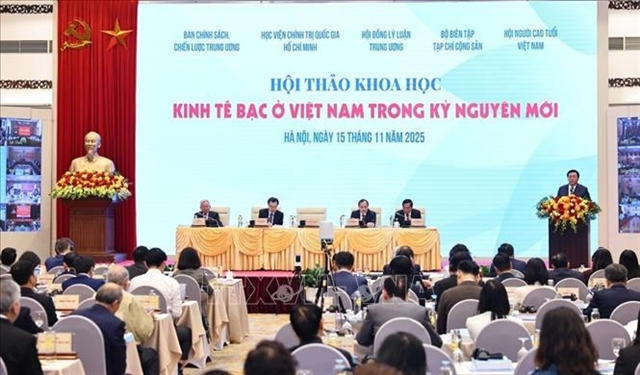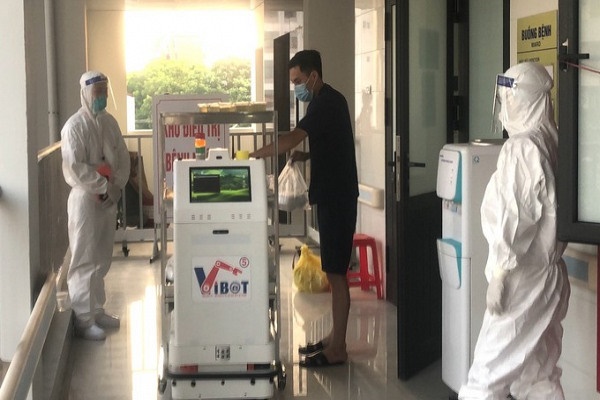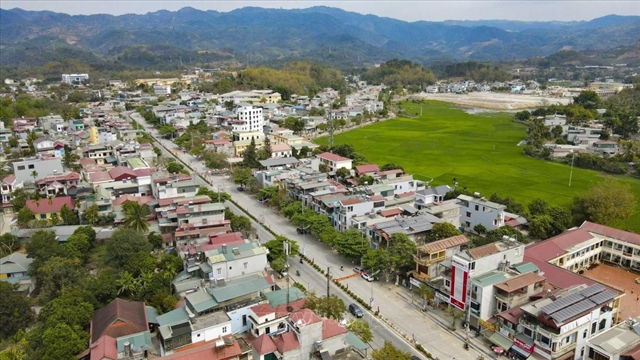 Society
Society


|
| A robot - Vibot-2 - used to deliver medicines, foods and other things in COVID-19 quarantine facilities. Photo courtesy Military Technical Academy |
HÀ NỘI — Artificial Intelligence (AI) technology is already playing a role in managing the current pandemic and could play an even bigger role in the future, according to Deputy Minister of Science and Technology Bùi Thế Duy.
AI technology has played an important role in helping to reduce the burden on medical staff during the COVID-19 pandemic, Duy said. Several practical applications have been realised since the pandemic took hold in fields like contact tracing and have been effective at containing new outbreaks and infections in the community.
AI has streamlined a number of processes, particularly in data collection.
“An image-to-text technology with the support of AI has helped digitise all declarations, epidemiological questionnaires and upload to the system,” Duy said.
When the number of infections in the community was increasing, being able to scan paper declarations and have computers do the rest was extremely helpful, Duy says.
But the application of AI during the pandemic didn’t stop there.
“When the pandemic became more complicated, AI was present in quarantine areas and hospitals with automatic robots to help disinfect, deliver shipments and transport medicine to patients,” he said.
The Epidemiological Mapping System (EMS) and infection risk assessment software have also been effective in pandemic-hit areas.
With the EMS users could track where infected persons had been and the locations of quarantine areas and hospitals.
It has also been suggested that future applications of AI could be to use the technology to monitor the distance between people in public places and quarantine facilities and detect people not wearing masks in crowded spaces.
Its ability to process data could be incredibly useful in the event of a future pandemic. AI could analyse data and make predictions about the size of the pandemic and provide real-time scenarios to help authorities proactively respond , Duy said.
Associate Professor. Dr. Phậm Xuân Đà, from the Medicine Faculty of HCM City’s National University recently combined IoT technology with AI to control groups of people in COVID-19 quarantine facilities, hospitals, industrial parks, border gates and crowded areas.
Cabins were erected in high traffic areas like the gates of apartment and office buildings, hospitals, quarantine establishments, and parks.
The cabins were equipped with facial recognition technology and could check the body temperature of a number of people at the same time.
According to Dr. Đà, this system could be very advantageous if F1 COVID-19 cases are quarantined at home in localities with a large number of patients.
Challenges
Developing the AI industry in Việt Nam however is not without its challenges.
Duy says that at present, those working in the AI field should not be limited to researchers, mathematicians and information technologists, but rather should be seen from a broader perspective of State management, policy, legal framework, human resources, infrastructure, and data management.
Dr Nguyễn Thanh Thủy, head of the AI Laboratory at Hà Nội National University and Vice President of the National Key Science and Technology Programme, says data and computing infrastructure are two of the three most important pillars for Việt Nam to research and develop.
“Accordingly, a clear understanding of the importance of data collection and organisation as well as data sharing mechanisms and computing infrastructure would help research and development units take advantage of and reach their full potential,” she said.
A lack of skills in the field has also been highlighted as a potential weakness.
Dr. Trần Minh Triết from HCM City’s National University, said training was key to effectively developing AI industries.
He also noted, however, that the training process needed to connect many different fields with AI’s strength realised most effectively when combined with expertise in other fields, he said.
The future of AI in Việt Nam
The launch of the International Research Centre on AI at Hà Nội’s University of Science and Technology, a training programme on AI and Robot Technology (AIC) at HCM City’s National University, and Vingroups’s AI engineer training programme marked the start of the National Strategy on Research, Development and Application of Artificial Intelligence
The Prime Minister, earlier this year, issued the National Strategy on Research, Development and Application of Artificial Intelligence (AI) to 2030 that aims to promote research, development and the application of AI and make AI an important part of Việt Nam’s high-tech sector moving forward.
The country sets a goal of building 10 prestigious AI brands in the region, developing three national centres for big data storage and high-performance computing and connecting domestic systems of high-performance data centres and computing centres to form a network of sharing big data and computing capacity for AI.
Deputy Minister of Science and Technology Bùi Thế says that AI was traditionally classified as an academic science and for mathematicians and information technology researchers and as a result its uses were limited.
In recent years, however, a number of technological innovations like big data, cloud computing technology, and deep learning have converged and brough AI into the mainstream.
Việt Nam aims to become a centre of innovation, development of AI solutions and applications in the ASEAN region by the year 2030. VNS




